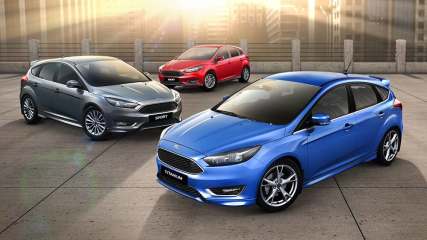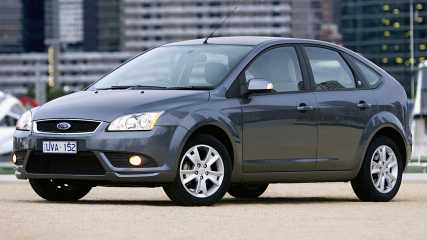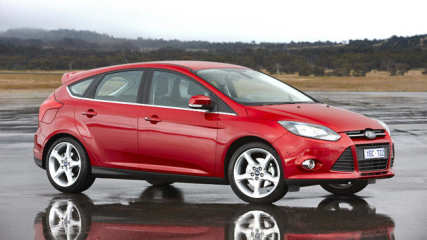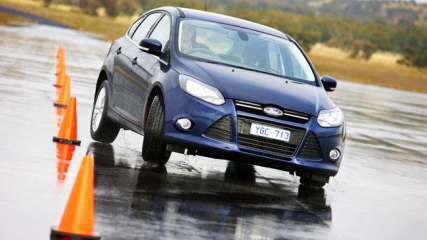Used Ford Focus review: 2005-2011
By Graham Smith · 19 Jun 2018
So focused was Ford on selling the Falcon that it lost sight of the Focus after its initial launch in 2002. With minimal marketing the LR Focus failed to excite the market, so there was plenty riding on the new LS model that arrived in 2005.The lack of backing for the LR was a sign Ford was throwing everything at the locally produced Falcon at the expense of all else at a time the market was beginning to tune in to smaller cars.Those who failed to see the first Focus missed out on a good car, one that deserved more attention than it got.The new LS Focus delivered European driving dynamics in a sophisticated, but still value-for-money package.The LS Focus was a more rounded car than the LR that preceded it.While the LR was lauded for its sportiness, the LS won more plaudits for its sophisticated feel, roominess and improved interior.There were two body styles, a five-door hatch and a four-door sedan, with two levels of trim, the CL and LX, available in each.In addition there was a sporty Zetec hatch and a luxury Ghia sedan.The LS was wider than the LR, its wheelbase was longer, and it was a little stiffer.Ford's designers moved away from the soft, rounded forms that were a feature of the LR and gave the LS a sharper, more chiseled look.The CL opened the door to the LS range. It was available as a sedan or hatch, it came with a 2.0-litre engine and there was the choice of a five-speed manual gearbox or four-speed automatic transmission.It also boasted plenty of standard goodies to please the small car buyer.Standard features included air conditioning, remote central locking, front fog lights, power steering, power front windows, a radio/CD player with four speakers, a trip computer, rear spoiler (hatch only), and there was an option pack that included 15-inch alloy wheels, power mirrors, and cruise control.Safety features consisted of airbags for the driver and front passenger, and seat belt pretensioners.Like the CL, the LX was available as a sedan or hatch, it had a 2.0-litre engine, and was available with a five-speed manual gearbox or a four-speed automatic transmission.Standard features included air conditioning, 16-inch alloy wheels, cruise control, remote central locking, front fog lights, power steering, power mirrors and windows, a radio/CD player with four speakers, an immobiliser, and a trip computer.Safety features consisted of airbags for the driver and front passenger, side front airbags, ABS anti-lock braking, and electronic brakeforce distribution.Ford of Europe has long been renowned for building cars that steer and handle brilliantly and the Focus was no exception.The Ghia was only available as a sedan with a 2.0-litre engine and four-speed automatic transmission.Befitting its position as the leader of the pack the Ghia had a host of standard features, including climate control air conditioning, 16-inch alloy wheels, cruise control, radio/CD player with four speakers and a six-disc stacker, remote central locking, front fog lights, power steering, power windows and mirrors, power drivers seat, and a trip computer.Safety features consisted of airbags for the driver and front passenger, side front airbags, seat belt pretensioners, ABS braking and electronic brakeforce distribution.For those looking for a sportier ride Ford offered them the Zetec hatch with the 2.0-litre engine and the choice of five-speed manual gearbox or four-speed automatic transmission.Standard features of the Zetec were climate control air conditioning, cruise control, remote central locking, fog lamps, immobilizer, power windows and mirrors, power steering, leather trim, power drivers seat, and a trip computer.Giving it a sporty flavor were 17-inch alloy wheels, a body kit, a rear spoiler, and sports suspension.Safety features consisted of airbags for the driver and front passenger, side front airbags, seat belt pretensioners, ABS anti-lock braking, and electronic brakeforce distribution.New to the range was the XR5 Turbo hot hatch with a turbocharged Volvo-sourced 2.5-litre five-cylinder engine and a six-speed manual gearbox.It had a full complement of standard features, including air conditioning, radio/CD player with eight speakers and a six-stacker, remote central locking, front fog lights, leather steering wheel, power windows and mirrors, power driver's seat, and a trip computer.Sporty features were 18-inch alloy wheels, sports-tuned suspension, rear spoiler, and sports seats.Safety features included airbags for the driver and front passenger, head airbags, side front airbags, ABS braking, emergency brake assist, electronic brakeforce distribution, electronic stability control, and traction control.The big news in 2007, when Ford updated the Focus, was the introduction of a 2.0-litre turbo-diesel engine option.Sadly, the TDCi was only available with a six-speed manual gearbox until a subsequent update in 2009 when it also became available with a six-speed dual-clutch automatic transmission.By then the Ghia was gone, but the range of sports models was expanded and now included the Zetec, the XR5 and the RS.The 2009 update also brought Bluetooth and the capability of connecting an iPhone or Android device, although it wasn't available in the base model CL.While Bluetooth technology was available there was no touchscreen, parking sensors, reversing camera, or a park assist system. Also absent were sat nav and a sunroof.The spare tyre was a temporary use space-saver.Fresh air fiends were covered with a coupe-cabriolet released in 2007.With a folding hardtop the CC offered the best of both worlds, open air with the roof folded and the security of a fixed-roof coupe with the roof up.The downside was the limited boot space with the roof folded.The Focus cabin had five seats in a conventional layout, with the hatch rear seat a split-fold deal to expand the capacity to carry luggage.Everyone had good head and legroom, and travelled in relative comfort.Some were critical of the comfort of the seats, which were typically firm in the European style.There were plenty of storage options spread around the cabin, and those in the front seats had the use of cupholders.Lap-sash seat belts facilitated the fitment of a baby car seat, but ISOFIX mounting points weren't fitted.The main engine was a 2.0-litre four-cylinder twin-cam petrol unit that produced 107kW (143 horsepower) and 185Nm when working at its respective power and torque peaks.It was available with a choice of a five-speed manual gearbox or a conventional four-speed automatic transmission.The performance choice was the 2.5-litre turbocharged five-cylinder engine Ford sourced from its (then) Volvo arm.It required the use of 95-octane premium unleaded to achieve its ultimate performance, which saw it put out 166kW (222 horsepower) and 320Nm.When at its best it was capable of completing the 0-100 km/h sprint in 6.8sec.Ford met the demand for a diesel engine in 2007 with the launch of the TDCi, which was powered by a 2.0-litre four-cylinder common-rail turbo-diesel that boasted 100kW of maximum power and 320Nm of peak torque.Initially it was only available with a six-speed manual gearbox, but the option of a six-speed dual-clutch automatic transmission was added in 2009.The appeal of the Focus was its driving dynamics. Ford of Europe has long been renowned for building cars that steer and handle brilliantly and the Focus was no exception.Aside from the trouble with the dual-clutch transmission in the TDCi the reliability of the Focus is generally good.A combination of MacPherson Strut independent front suspension and 'Control Blade' independent rear suspension finely tuned by Ford's suspension experts meant anyone looking for a rewarding driving experience could do no worse than settle into a Focus.It might have been a conventional front-wheel drive, but it was a delight to drive.The agile and responsive handling didn't come at the cost of ride comfort; the ride was smooth and supple.Road noise was an issue, particularly in hatches.The Focus was well equipped with safety features for the time.All models in the range had airbags for the driver and front passenger, and side front airbags became standard in 2008.ABS braking was standard on the Ghia from 2005, and across the range from 2007.ANCAP rated the Focus four stars out of five.In recent years the Focus badge has become tainted by the problems that beset the 'Powershift' dual-clutch automatic transmission.The only model fitted with the dual-clutch auto in this generation of the Focus was the TDCi when the Powershift auto was released on the diesel engine in 2009.Anyone considering an automatic TDCi should think long and hard before buying one. History now tells us that the dual-clutch is trouble, and should be avoided.But the automatic transmission used across the rest of the range was a conventional automatic and that is trouble free.Aside from the trouble with the dual-clutch transmission in the TDCi the reliability of the Focus is generally good, but of course buying a used car demands careful inspection.The best buy is always the one with the fewest kilometres with a known history of ownership and service. Tick those boxes and you won't go far wrong with the Focus.Build quality was a concern with the Focus; it wasn't as good as those cars coming from Asia.With that in mind check all electrics in the car to make sure everything is working.Brakes tend to wear out quicker than some cars; it's a factor of the 'driving' nature of the car.A cam timing chain eliminated the need and extra cost of replacing a belt.Capped price servicing didn't apply to the Focus, but there's nothing that should make it an expensive car to maintain, and using an independent mechanic can contain service costs.Ford recommended servicing the Focus every 12 months or 15,000 km, whichever came first.The warranty was for three-years/100,000 km, but that has long since expired.There was a recall for a batch of turbo-diesels built between 2007 and 2009 without an exhaust system heat shield.Another one was for some cars built between 2008 and 2009 with a potentially faulty brake booster.MORE: If anything crops up, you'll probably find it on our Ford Focus problems.Kim Odgers: I bought my CL hatch new in 2007 when it caught my eye at the dealer. All these years later I still have it and love it. I love driving it, and it has been very reliable.Kerry Hampton: We've had our CL for years and have had not trouble to speak of. It's good to drive, and easy to manoeuvre and park.Billy Ahrens: I've had my 2007 Zetec hatch for three years. It's a lovely car, easy to drive, parking is a breeze, it's comfortable, but the road noise is awful.Michael Firth: I owned a 2006 LX for two years, but sold it because the seats were uncomfortable, the road noise was high, and the build quality was awful.Toyota CorollaDurable and reliable as they come and holds its value well.3.5 stars.VW GolfA car you want to love, but more likely will loathe because of the troubles with the DSG gearbox.3 stars.Mazda3A favourite small car that ticks all the boxes.3.5 stars.A car you can enjoy driving, if you avoid the Powershift transmission.



.jpg)





